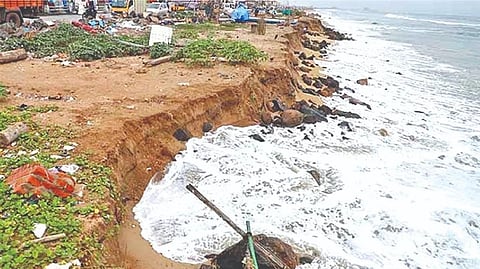

NEW DELHI: Indian governments, without exception, have been known to tiptoe around environmental concerns while paying lip service to them. This has been the norm ever since the Environment Protection Act came into being in 1986.
But even our lip service tends to be informed by urban and electoral concerns, as in the periodic kerfuffle over New Delhi’s air quality or Bengaluru’s lake of froth, Bellandur.
So it’s no surprise that coastal erosion affecting peninsular India hardly gets a mention in our cant.
Yet the importance of arresting coastal erosion can hardly be overstated. India’s coastline of 7,500 km covers 78 districts in nine states and four union territories. These are home to 14.2 per cent of our population and 3,288 marine fishing villages.
Moreover, precious coastal and marine ecosystems such as the Sundarbans and Gahirmatha marine sanctuary cover a total of 34,000 sq km. These populations and ecosystems are vulnerable due to coastal erosion, which has registered dangerous levels in recent studies.
The latest National Assessment of Shoreline Changes by the National Centre for Coastal Research (NCCR) says that 33.6 per cent of India’s coastline is subject to erosion and warns that “coastal erosion has become one of the most alarming threats in varying pockets along the Indian coast”.
Of the nine coastal states, those on the eastern seaboard are more vulnerable with West Bengal (60.5 per cent), Tamil Nadu (42.2%) and Puducherry (56.2%) showing a high trend of erosion while on the west, 46 per cent of Kerala’s shoreline displays such conditions.
Shoreline changes can be due to coastal accretion (deposition of sediment) too. On that score, India’s coastline is highly dynamic with 33.6% of it undergoing erosion, 27% accretion and 39.6% stable.
This effectively means that land is being lost at one place and gained in another.
Odisha has a high accretion rate of 51%, but that does not mean its marine villages are not vulnerable to erosion.
Data put out by the National Centre for Sustainable Coastal Management show that Odisha has 74 vulnerable villages, the highest in the country.
West Bengal has lost 99 sq km of land over the past 26 years, according to the NCCR study. There are no less than 92 erosion hotspots in the nine coastal states/UTs mapped.
The rise in sea levels (40 cm in the past 100 years) can be blamed for only a part of this problem. Anthropogenic causes such as urbanisation, industrial activity, tourism, destruction of natural buffers and sand mining make it much graver.
The good news is that we now have the technology to map these shoreline changes precisely and the time-series data to be able to model for any kind of change in land use. These models should be taken into consideration at the pre-feasibility stage of planning for infrastructure and industrial activity and not after the deed is done.
The west coast is stabler due to its geomorphology of rocky cliffs while the east coast with its large deltas, beaches, mangroves and lagoons is more subject to erosion or accretion.
While these latter features might excite policymakers for their potential for tourism and seaside entertainment, development in that direction needs to be tempered with environmental concerns.
Caring for the environment demands commitment, not lip service. Had that been the case, we would not have had the embarrassment of seeing our expressways inundated a week after inauguration.
Visit news.dtnext.in to explore our interactive epaper!
Download the DT Next app for more exciting features!
Click here for iOS
Click here for Android